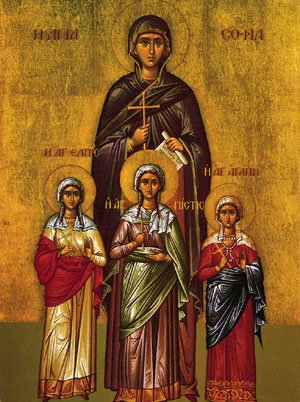
Saint Sophia and her Three Daughters

Saint Sophia The Martyr and her Daughters. (Faith, Hope, Love/Charity)
According to the Orthodox Church Sophia was a Christian woman born in Rome during the reign of Emperor Hadrian (117-138 AD). Sophia was born into a respectable pious Christian family, and it is said that she was especially vocal about her devotion to the early church.
She would go on to marry and bare six children, the most famous of which are her three daughters. Faith, Hope, and Love (charity) whom she raised to be just as pious and devoted to the church as she herself was. So devoted and pious in fact it is said that Sophia and her daughters had no qualms about publicly criticizing even the emperor for his sinful lifestyle.
Legend states that due to her devotion and vocal criticism of Emperor Hadrian, she along with her daughters, were summoned to appear before the emperor in the year 126 CE (136-137 by some accounts). When Sophia and her daughters where introduced to the emperor, he demanded that she renounce her faith and declare her loyalty to him (in some versions he demands she makes offerings to various Roman gods). Sophia refused and instead scolded Hadrian for his lavish lifestyle and pagan idolatry. Shocked but impressed by her pois and bold manner the emperor decided that if he could not make Sophia submit, then her would break her daughters. So the emperor called forth the oldest of her daughters, 12 year old Faith.
The Emperor questioned the young twelve-year-old about her Christian devotion, at which point Faith admonished Hadrian for his behavior and sinful ways. So angered was the emperor that he had her tortured, mutilated, and finally when she would not recant her devotion and criticisms…beheaded in front of Sophia.
The emperor again ordered Sophia to renounce her devotion and recant her criticisms of him, and again Sophia declared her devotion to Christ and rebuked the emperor for his sinful ways.
Next the Emperor called the middle daughter, Hope, who was in her 10 year. Just as with her older sister Hope openly declared her devotion to Christ and criticized the emperor. And just as with her sister Hope was tortured and put to death. Again, Sophia refused to submit to the emperor and praised Christ.
Love (charity) was summoned next, being only 9 and the youngest of Sophia’s daughters. She too would praise the piety and holy nature of Christ and condemn the emperor. The emperor showing no mercy ordered the child to share the fate of her older sisters while her mother was again forced to watch.
It is Said that so overcome by grief over the death of her daughters, that Sophia refused to leave them even in death. She sat in morning and prayer for three days by their gravesides until she too passed. Some say that Sophia and her daughters all were raised and delivered into the heavens by angels.
That is one Legend. Another states that Sophia did not die at the graves of her daughter, but after three days of constant morning and prayer she fell into a deep sleep where she received a vision from god. In this vision the spirit of heaven told her that for their devotion her daughters would be gifts to all the faithful (Faith, Hope, Love) , And for her devotion she would become the mother of many. After this Sophia would return to her home where she would take in lost or abandoned children, and after many years turned her house into a orphanage. In this version she is seen as patron saint of orphans and motherhood.
It must be stated that there are several “Saint Sophia’s” with very similar stories throughout early Christian legends and the story of her and her daughters have been observed and recorded in several different regions with various discrepancies, with the Eastern orthodox version simply being the most widely known and observed.
Historically scholars are unsure if Saint Sophia (and her daughters) was one or several different early Christian martyrs whose stories became merged or equated together during the middle ages. It is also thought by some that Sophia and her daughters may have not existed at all in life, the story being a metaphor barrowed from earlier pagan mythology.
Some Gnostic teachings see the story of Saint Sophia and her daughters as a metaphor. Sophia (wisdom) being equated with the Mother Goddesses, and her daughters being taken from her is equated with mankind turning away from her (wisdom) and taking her gifts (Faith, Hope, Love/charity) for granted ultimately loosing them in foolish pursuits.
The name Sophia means "wisdom" in Greek; as for her daughters' names, Faith, Hope, and Love (Charity), they are Pistis, Elpis, and Agape in Greek, and Vera, Nadezhda, and Lyubov in Russian.
September 17th is observed as the feast day honoring St. Sophia and her Three daughters. She is seen by many to be the patron saint of Motherhood, piety, and Orphans.

Leave a comment